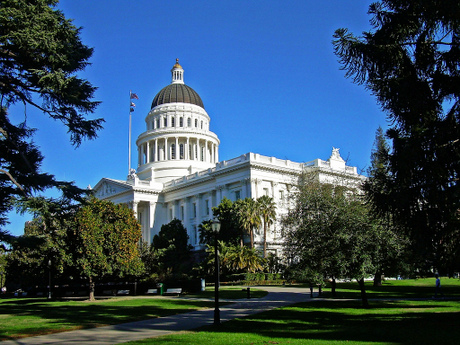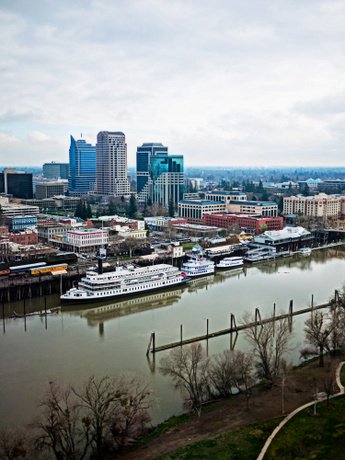Discovering the Adventure
Sacramento California
Sacramento California's Human History
Dates Way Back
The Sacramento California region has always been important to humans, to the history of California, and to the development of the nation - long before it was a city and even before it was called Sacramento!
The confluence of two great rivers, the Sacramento and the American, provided abundant flow, fertile soil, mild climate, and natural transportation systems, all of which have attracted human settlement for over 12,000 years.
Sacramento California:
From Native Americans to John Sutter
Native Americans lived in the region for many thousands of years before Europeans had even discovered the American continents.
They prospered from the abundance in the fields and forests around them, and in the waters of the area's rivers and streams.
Then came the Swiss pioneer, John Sutter, arriving around 1839 to establish his trading colony, New Helvetia (later to be called Sutter's Fort).
Recognizing the fertility of the surrounding land, the long growing season provided by Sacramento weather, and the value of the nearby rivers as transportation conduits, Sutter planned to build himself an empire.
He was in the process of involving himself and his people in all of the industrial pursuits needed by a self-sufficient community when James Marshall - his Mill Foreman - discovered gold at Sutter's Mill in Coloma.
That was the beginning of the end for John Sutter's plans, as most of his workers - along with the rest of the world, it seemed - ran off to the California Goldfields to try their hand at getting rich quick!
As California grew from the influx of gold seekers and those who
would inevitably follow, Sacramento California became more and more
important. In fact, it was ultimately THE major distribution point for
goods, services, and humanity; a commercial and agricultural center; the
end of the line for wagon trains, riverboats, the telegraph,
stagecoaches, the first transcontinental railroad, and even the Pony
Express!
Sacramento California Today
From Pioneer Fort to State Capital
Sacramento is important today because it's not only California's State Capital, it's also County Seat for the County of Sacramento - Government Central, so to speak!
Take a look at its location and its history, and that should come as no surprise! Sacramento California sits exactly on the spot where the American River joins the Sacramento River, providing excellent access to both the Bay Area to the West, and to the interior regions to the East. You can actually stand on a point at Discovery Park and watch the American flow into the Sacramento - pretty heady stuff!
That's what made the city important during the Gold Rush, and that's what makes it an important center for government today!
Sacramento's been the County Seat since the County of Sacramento was created in 1850, but it's only been the official State Capital since 1879. However, the California State Legislature moved to Sacramento and conducted their business from there beginning in 1854, so even then it was the de facto capital.
The beautiful Capitol building, which was modeled after the nation's Capitol in Washington, D.C., is a noble example of neoclassic American government architecture, and was constructed between 1860 and 1874.
The Capitol is within easy walking distance of the other half of the importance equation - Sacramento's history in the form of Old Sacramento, which lines the Sacramento River riverfront.
This is the site where the 49ers arrived from San Francisco before setting off for the gold fields. This is where the prospectors returned when they'd found their fortunes, or to lick their wounds when they hadn't found gold. This is where trade and commerce prospered in the early years.
Visit Sacramento California today and you'll have the opportunity to see how it all came together! First explore Sutter's Fort State Historic Park for a realistic look at what life was like for John Sutter and the pioneers who crossed the mountains by wagon train.
Then head for Old Sacramento to see where and how the transition took place between John Sutter's vision for the region and the modern-day reality.
Finally, visit the State Capitol building, which is both a working seat of government, and a museum that's open to the public, with public tours conducted several times per day, and several restored historic offices on display.
These sites comprise an historical tour that you can do in one long day if you wish, but it's worth taking your time to visit each of the three in depth if you can!
Sacramento California Has Stately Charm
Today the City of Sacramento is a modern hub of governmental and commercial activity, but it's also a city of stately, tree-lined avenues, excellent restaurants, and genteel Victorian homes.
Sacramento weather is Mediterranean in nature, with damp mild winters and hot dry summers. But, while much of the Central Valley's hot dry summers are truly hot and dry, California's Capital City has the advantage of delta breezes coming up the river to bring temps down by as much as ten or fifteen degrees!
Sacramento restaurants cover the spectrum of casual dining to fine, ethnic cuisine to seafood, historic to new and trendy. The one thing you won't run out of is places to eat!
Locals divide Sacramento into several districts or neighborhoods. Midtown Sacramento (or simply, Midtown) is where you'll find the charming tree-lined streets with stately and elegant historic Victorian homes. Although the area is largely residential, it also plays host to the art, music, and cultural scene of the city.
Downtown Sacramento is the central business district and includes the Capitol grounds, Westfield Downtown Plaza, Sacramento City Hall, and the convention center complex.
Old Sacramento is the historic old town that most towns and cities boast of, but it's also a hub of shopping, nightlife, entertainment, and dining. With events like the St. Patrick's Day Parade, Underground Tours, Gold Rush Days, and Theater of Lights, there's always something going on!
William Land Park is 166 acres of well-manicured lawns, picnic areas, sports fields, play areas, gardens, jogging trails, and a golf course. Usually referred to as simply Land Park, it's located within the city limits, and just South of central Sacramento.
Land Park is also a wonderful destination for the kidlettes as it's home to the Sacramento Zoo, Funderland Amusement Park, and Fairytale Town - all popular kidlette attractions!
But in addition to the municipal park, Land Park refers to the surrounding neighborhood filled with charming homes built in the 1920s, '30s, and '40s.
And speaking of charming neighborhoods, we can't leave Sacramento California without tipping our hats to the Fabulous Forties (or Fab 40s), an historic and posh neighborhood about three miles East of downtown that contains a beautiful combination of architecturally significant mansions and bungalows, and is probably the priciest piece of real estate in the entire Greater Sacramento area!
We'll have more to share with you about Sacramento California in the coming weeks; things like:
- Sacramento Attractions
Enough to keep you busy for weeks! - Sacramento Beaches
And other water-borne adventures! - Sacramento Parks
From Discovery Park to Land Park!
Please continue your exploration of what Northern California has to offer by using the Nav Bars in the left and right columns or by using the links at the bottom of the page.
Like what you're finding here at Discovering Northern California? Then please share with the Social Network of your choice.
And thanks for coming!
- Home Page
- Sacramento CA
Related Articles
California's Central Valley
Related Pages
California Gold Rush
California Gold Rush
Discovery of Gold
Getting to California
Gold Rush Trail
Gold Rush Sites
Gold Panning
Related Pages
Hints & Tips
Beach Safety Tips
Best Kept Travel Secrets
Family Camping Tips
iPhone Travel Apps
Nude Beaches
Tide Pool Tips
Travel Sites We Love
Travel Tips
Whale Watching Tips
Wine Tasting Tips
Winter Driving Tips
Related Pages
Things To Do
Activity Village
Attractions
Beaches
Beer Lovers Delight
Burney Falls
Camping
Casa de Fruta
Day Trips
Gold Panning
Gold Rush Sites
Healdsburg
Historic Grass Valley
Lake Shasta Caverns
Lodi
Missions
Nevada City
RV Destinations
Ski Resorts
Tide Pool Tips
Travel Tips
Weekend Trips
Whale Watching
Wine Tasting
Related Pages
Free Things To Do
Free in Big Sur
Free in Chico
Free in San Francisco
Free in Sonoma
Related Pages
Insider Secrets
Best Kept Travel Secrets
Best Winter Whitewater
Boring Road? Nope
CA Admission Day
Climbing at Castle Rock
Crabbing Spots
Dream of Dreams
Fall in Eastern Sierras
Ghost Stories
Glass Beach
Great Stays, Low Pays
How to be a Valley Girl
Jade Beach
Lake Shasta Caverns
Lassen Volcanic SP
Lost Coast
Mono Lake
Moss Landing: Whales
New Clairvaux Abbey
Panning for Gold
Pygmy Forest
Mendo to Eureka
RV Destinations
SF Great Places to Eat
SF: More About Eating
SF Neighborhoods
SF Giants Baseball
Santa Cruz: Memories
Santa Cruz: Old Friends
Sonoma Cooking Class
Sonoma History
Sonoma Top Wine Stop
Tahoe: Discovery Trail
Underground Gardens
Yosemite: Family Hikes
Yosemite: High Country
YNP: Off the Beaten Path
Yosemite: Taft Point
Ziplines


